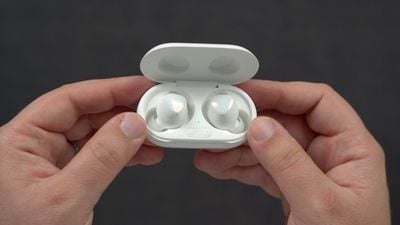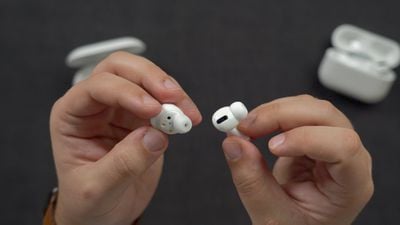Samsung at its Unpacked Event in San Francisco this week unveiled the new Galaxy Z Flip and the S20 smartphone lineup, and accompanying its new flagship devices, Samsung also launched its next-generation wire-free earbuds, the Galaxy Buds+.
In our latest YouTube video, we took a look at the new Galaxy Buds+ to test them out, and we did a quick comparison with the AirPods and the AirPods Pro.
Design wise, the Galaxy Buds+ look pretty much identical to the original Galaxy Buds, but there's an extra microphone that's been added and the charging case now has a glossy finish instead of a matte finish. The size, fit, and comfort are unchanged.
The Galaxy Buds+ are closer in design to the AirPods Pro than the AirPods because of the soft silicone tips that fit into the ear canal to provide a tighter seal, but there is no noise canceling technology included in the Galaxy Buds+.

With the second-generation version of the Galaxy Buds, Samsung aimed to improve audio quality for music and phone calls along with battery life, both of which do seem to be better. The Galaxy Buds+ now last for 11 hours before needing to be recharged with the case, and the sound seems to be improved.
Though closer in design to the AirPods Pro, the price point and the functionality of the Galaxy Buds+ better matches the standard AirPods. The Galaxy Buds+ are $149, so $10 cheaper than the standard AirPods without charging case and $100 cheaper than the AirPods Pro.

There are touch controls on each Galaxy Bud+ earbud, which can be used to play/pause, skip tracks, and activate voice assistants. Those are the only three functions available when connecting the Galaxy Buds+ to the iPhone, but with an Android device, the long press function can be customized to auto-launch Spotify.
Samsung also offers tools for controlling ambient sound levels (though we didn't notice much of a difference with this enabled), and adjusting the sound profile. There are a few preset options for increasing bass or treble and there's an option for making audio more dynamic or soft. There's no true equalizer function, but it's better than what's available for AirPods, which is nothing.
Galaxy Buds+ on Android can read notifications to you, a function not available when using them with the iPhone. AirPods offer a similar function in iOS 13, allowing Siri to announce incoming messages.

Galaxy Buds+ can also be connected to multiple devices at the same time such as a TV and an Android phone so you can hear incoming notifications, but this is not a feature that works when using them with an iPhone.
Overall, the Galaxy Buds+ audio seems to be improved and they sound better than the AirPods, but there's not a huge difference. There is a major difference in sound quality compared to the AirPods Pro in favor of the AirPods Pro, but that's probably not a fair comparison given the Galaxy Buds+ are $100 cheaper and not meant to compete with Apple's noise canceling headphones.
Android users who have considered getting AirPods for their smartphones might want to consider the Galaxy Buds+ instead, but those who use both iOS and Android may still want to go for the regular AirPods because of the H1 chip functionality. The H1 chip in the AirPods and AirPods Pro powers hands-free "Hey Siri" requests, improves connectivity and improves range, and also enables fast switching between Apple devices connected to the same iCloud account.
What do you think of Samsung's improved Galaxy Buds+? Let us know in the comments.





















